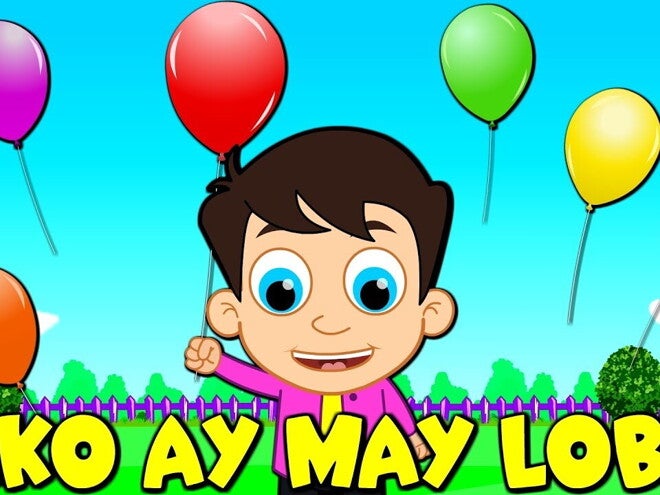
When her toddler Athena gets restless, mom-fluencer Chelsy Nicole Yambao (also known as Mommy Selsi) entertains her with beloved Filipino nursery rhymes like "Ako ay May Lobo." For bedtime, she soothes her daughter with a lullaby such as "Sa Ugoy ng Duyan," a song her own mother used to sing to her.
Parents have loved these songs for generations for a simple reason: they create a moment of connection while also supporting your child's mental and emotional development.
From boosting your child's language skills to strengthening your bond, explore the beloved tunes that make learning through play a joyful part of your day.
What Are Nursery Rhymes and Lullabies?

A nursery rhyme is perfect for playtime, while a lullaby is a gentle song meant to soothe your baby to sleep.
Nursery rhymes, also known as awiting pambata, are timeless children’s songs and poems passed down through generations. Many nursery rhymes are traditional tunes from different regions that tell stories about nature, family, or playtime. Their catchy melodies and easy-to-remember lyrics make them perfect for teaching a lesson or starting a game with your little one.
On the other hand, a lullaby (or oyayi) is a slow song meant to soothe a child to sleep.
25 Popular Filipino Nursery Rhymes and Lullabies
Here, you'll find a wonderful mix of songs for your little one, from traditional Filipino folk songs to local versions of well-known English rhymes.
1. Bahay Kubo
Bahay kubo, kahit munti / Ang halaman doon ay sari-sari…
Introduce your toddler to various local vegetables with this educational rhyme. This nursery rhyme song paints a picture of a nipa hut with a thriving garden, making it a great way to expand your child’s vocabulary.
2. Leron, Leron Sinta
Leron, leron sinta / Buko ng papaya / Dala-dala'y buslo / Sisidlan ng bunga…
A Filipino classic, this folk song tells the story of a man climbing a papaya tree to pick fruit for his beloved. Your child will love its catchy, upbeat tune, which makes it a favorite for school performances.
3. Sa Ugoy ng Duyan
Sana'y di nagmaliw ang dati kong araw / Nang munti pang bata sa piling ni nanay…
One of the most famous baby lullaby songs, "Sa Ugoy ng Duyan," captures a mother’s love. Just a warning, though: this classic is a tearjerker for parents!
4. Tatlong Bibe
May tatlong bibe akong nakita / Mataba, mapayat mga bibe
Adapted from the popular English rhyme "Three Little Ducks," this catchy tune's simple melody teaches your child how to count as they sing and dance along.
5. Pen Pen de Sarapen
Pen-pen de sarapen / De kutsilyo, de almasen / Haw-haw de carabao / Batuten…
Kids use this counting-out rhyme in games like hide-and-seek or tag. Its nonsensical lyrics and rhythmic chant make it perfect for randomly choosing a player to start the game.
6. Ili-Ili Tulog Anay
Ili-ili, tulog anay / Wala diri imong Nanay / Kadto tienda bakal papay / Ili-ili, tulog anay…
This Visayan lullaby song has a gentle, soothing melody that's ideal for rocking your baby to sleep. The lyrics tell your little one to rest while mom takes a short break, promising she will return soon.
7. Tong Tong Tong Pakitong-kitong
Tong tong tong tong pakitong-kitong / Alimango sa dagat…
Teach your toddler this action rhyme about a crab that’s hard to catch. Its lyrics are repetitive and straightforward, and you can use your fingers to mimic the crab's snapping pincers.
8. Ako ay May Lobo
Ako ay may lobo / Lumipad sa langit / 'Di ko na nakita / Pumutok na pala
A simple story about a child whose balloon flew away, "Ako ay may Lobo," is a lighthearted way to introduce the idea of taking care of one's belongings.
9. Paru-Parong Bukid
Paru-parong bukid na lilipad-lipad / Sa gitna ng daan papaga-pagaspas…
With its cheerful, waltz-like rhythm, this folk song compares a graceful woman to a butterfly fluttering in a field. You’ll often hear it in school performances and cultural folk dances.
10. Sitsiritsit, Alibangbang
Sitsiritsit, alibangbang / Salaginto't salagubang
Known for its playful and sometimes silly lyrics, this humorous song dates back to the Spanish era. It pokes fun at different characters, offering a glimpse into the daily lives of Filipinos during that time.
11. Maliliit na Gagamba
Maliliit na gagamba / Umakyat sa sanga
You can sing this Filipino version of "Itsy Bitsy Spider," a lesson in perseverance. Use the familiar hand gestures as you tell the story of the spider climbing right back up after being washed away.
12. Sampung Mga Daliri
Sampung mga daliri kamay at paa / Dalawang tainga, dalawang mata / Ilong na Maganda
Perfect for learning how to count, this nursery rhyme for kids also helps your toddler learn about their body parts.
13. Paa, Tuhod, Balikat, Ulo
Paa, tuhod, balikat, ulo / Paa, tuhod, balikat, ulo
Get your child moving with this local version of "Head, Shoulders, Knees, and Toes." This energetic action song is an entertaining way for them to learn about their body while playing with you.
14. Kung Ikaw ay Masaya
Kung ikaw ay masaya tumawa ka (hahaha)
Teach your toddler how to express emotions with this Filipino version of "If You're Happy and You Know It." Have your child clap their hands, stomp their feet, and shout for joy during playtime.
15. Si Felimon
Si Felimon, Si Felimon / Namasol sa kadagatan
A popular Cebuano folk song, "Si Felimon," (sometimes spelled as Pelimon) gives a small glimpse into the daily lives of local fishermen. It tells the story of a fisherman catching a fish, selling it, and spending his earnings, showing the value of his work.
16. Jack en Poy
Jack en poy / Hale hale hoy / Sinung matalo siyang unggoy
The classic chant for the hand game "Rock, Paper, Scissors" originates from the Japanese game of jankenpon. You can use this rhyme to decide who goes first in a game.
17. Nanay, Tatay
Nanay, Tatay, gusto ko’ng tinapay / Ate, Kuya, gusto ko’ng kape / Lahat ng gusto ko ay susundin niyo / Ang magkamali ay pipingutin ko
Your younger toddler will love saying this rhythmic poem as part of a clapping game. The verses are short and simple, making them easy to learn.
18. Tiririt ng Maya
Tiririt ng Maya / Tiririt ng ibon / Ang huni ng tiyan ko'y / Tinumis na baboy
Make your child smile with this humorous song comparing the chirping sound (tiririt) of a Maya bird to the rumbling of a hungry tummy. It’s a witty and relatable rhyme that could just get your picky eater to look forward to mealtimes.
19. Magtanim Ay Di Biro
Magtanim ay 'di biro / Maghapong nakayuko / 'Di man lang makaupo / 'Di man lang makatayo
Use this folk song to teach your preschooler about the hard work of farmers and to appreciate the value of the food on the table. Its lyrics describe farming, from bending over all day to planting rice under the hot sun.
20. Lubilubi
Enero, Pebrero, Marso, Abril, Mayo / Hunyo, Hulyo, Agosto
This children's song has a catchy, repetitive rhythm that makes it easy for kids to memorize the months from January to December.
21. Ang Mga Ibon na Lumilipad
Ang mga ibon na lumilipad / Ay mahal ng Diyos di kumukupas…
The lyrics paint a picture of God’s love for the birds, the fish, and all the children playing.
22. Isa, Dalawa, Tatlo
Isa, Dalawa, Tatlo / Una-unahan tayo / Apat, Lima, Anim / Sa balong malalim
Help your toddler learn their numbers in Filipino during playtime with this simple and catchy counting rhyme.
23. Awit ng Pag-asa
Dinggin ang munting tinig / May nais ipahatid / Mga pangarap ko / Para sa 'ting daigdig…
While it isn't a lullaby, "Awit ng Pag-Asa" is a wonderfully uplifting song to sing to your preschooler. It conveys a beautiful message about staying positive and finding strength during challenging times.
24. Munting Bituin
Maliwanag na Bituin / Di ka ba nalulungkot / Sa paligid na dilim / Di ka ba natatakot / Kumapit ka ng mahigpit / Baka ikaw ay mahulog
Soothe your little one with this bedtime tune. This local version of "Twinkle, Twinkle, Little Star" is a classic oyayi that talks about the shining stars in the night sky.
25. Masaya Kung Sama Sama
Masaya kung sama-sama ang magkakaibigan / Masaya kung sama-sama at may tawanan
A popular song about togetherness, you can use this tune to teach toddlers about friendship and the joy of being part of a group.
5 Benefits of Nursery Rhymes and Lullabies

Filipino nursery rhymes can help improve your child's memory, vocabulary, and cognitive skills from an early age.
Singing these timeless songs makes your child smile and supports their growth. Here are a few of their benefits:
1. Builds language and literacy skills
A recent study in Frontiers in Psychology showed that babies as young as 10.5 months can already perceive rhymes in songs. This early ability was linked to having a larger vocabulary by the time they turned 18 months old.
2. Boosts memory and cognitive function
Children are highly skilled at using rhymes to lock words into their memory, making it a powerful tool for learning. A study in the Journal of Developmental Science found that 4-year-olds who listened to a rhyming poem for ten days significantly outperformed adults in remembering it word-for-word.
3. Strengthens your emotional bond
A study on the Lullaby Project found that the act of creating a song gave the parents a deep sense of meaning and connectedness with their child. While you don't need to write your own, singing a lullaby still strengthens your bond.
4. Promotes a sense of calm
Singing a soothing song to your child creates a calming feeling that supports their physical well-being. A recent study in the Journal of Perinatal & Neonatal Nursing found that when mothers sang lullabies to premature babies, it helped stabilize their heart rates and oxygen saturation levels, leading to higher overall comfort.
5. Connects your children to Filipino culture
These rhymes are often the same ones you grew up with, passed down by your parents. When you sing them to your child, you're connecting them to their rich Filipino heritage.
How to Introduce Filipino Nursery Rhymes to Modern Families
In a world of digital distractions, sharing these beloved songs is easier than you think.
Make it routine
Sing a playful rhyme during bath time or a gentle lullaby before bed. Consistency makes it a special part of the day that your child will look forward to.
Use online videos
Look for animated Filipino nursery rhymes on YouTube. These videos can capture your child’s attention and bring the stories to life.
Turn rhymes into action games
Incorporate rhymes into your games. Use songs like “Paa, Tuhod, Balikat, Ulo” to get your child moving while learning body parts. Letting your child lead playtime with these songs can be even more beneficial.
Whether you’re soothing your child with “Munting Bituin” or making your toddler giggle with “Tatlong Bibe,” you’re now equipped with various Filipino nursery rhymes and lullabies. These songs and poems are ideal for enriching their lives with music, learning, and culture.
Connect with other parents on the ParentTeam Moms and Dads Facebook group and share your favorite Filipino nursery rhymes and lullabies.
References
Cambridge Dictionary. “Nursery Rhyme.” Accessed June 30, 2025. https://dictionary.cambridge.org/us/dictionary/english/nursery-rhyme
Cuezon, Mario L. “LEARNING FROM WOMEN AND CHILDREN, THE SCHOLARS AND THE ORDINARY MAN ON THE STREET: THE FILIPINO NURSERY RHYMES.” Aghamtao 13 (2004). Accessed June 30, 2025. https://pssc.org.ph/wp-content/pssc-archives/Aghamtao/2004/vol%2013/13_Learning%20from%20Women%20and%20Children,%20Educating%20the%20Scholars%20and%20the%20Ordinary%20Man%20on%20the%20Street_%20T.pdf
EBSCO. “Nursery Rhyme | EBSCO Research Starters.” Accessed June 30, 2025. https://www.ebsco.com/research-starters/literature-and-writing/nursery-rhyme
Pineda, Amiel. “Lullabies and Nursery Rhymes: Filipino for Children.” Fluent Filipino. Accessed June 30, 2025. https://fluentfilipino.com/lullabies-and-nursery-rhymes-filipino-for-children/
UNICEF. “How Music Affects Your Baby’s Brain: Mini Parenting Master Class.” Video. Accessed June 30, 2025. https://www.unicef.org/parenting/child-development/how-music-affects-your-babys-brain-class
van der Straaten, Merel, Carmen van der Veen, Nienke van der Marel-van der Schaaf, Marit van der Heijden, Manon Benders, and Jeroen Dudink. “Impact of Daily Music on Comfort Scores in Preterm Infants: A Randomized Controlled Trial.” Pediatric Research, May 29, 2024. Accessed June 30, 2025. https://www.nature.com/articles/s41390-024-03586-6.






























